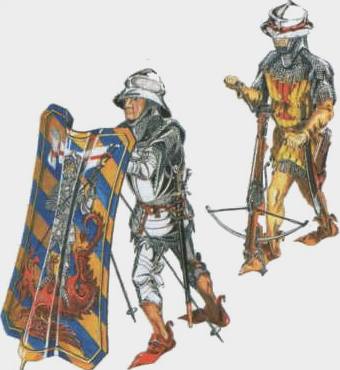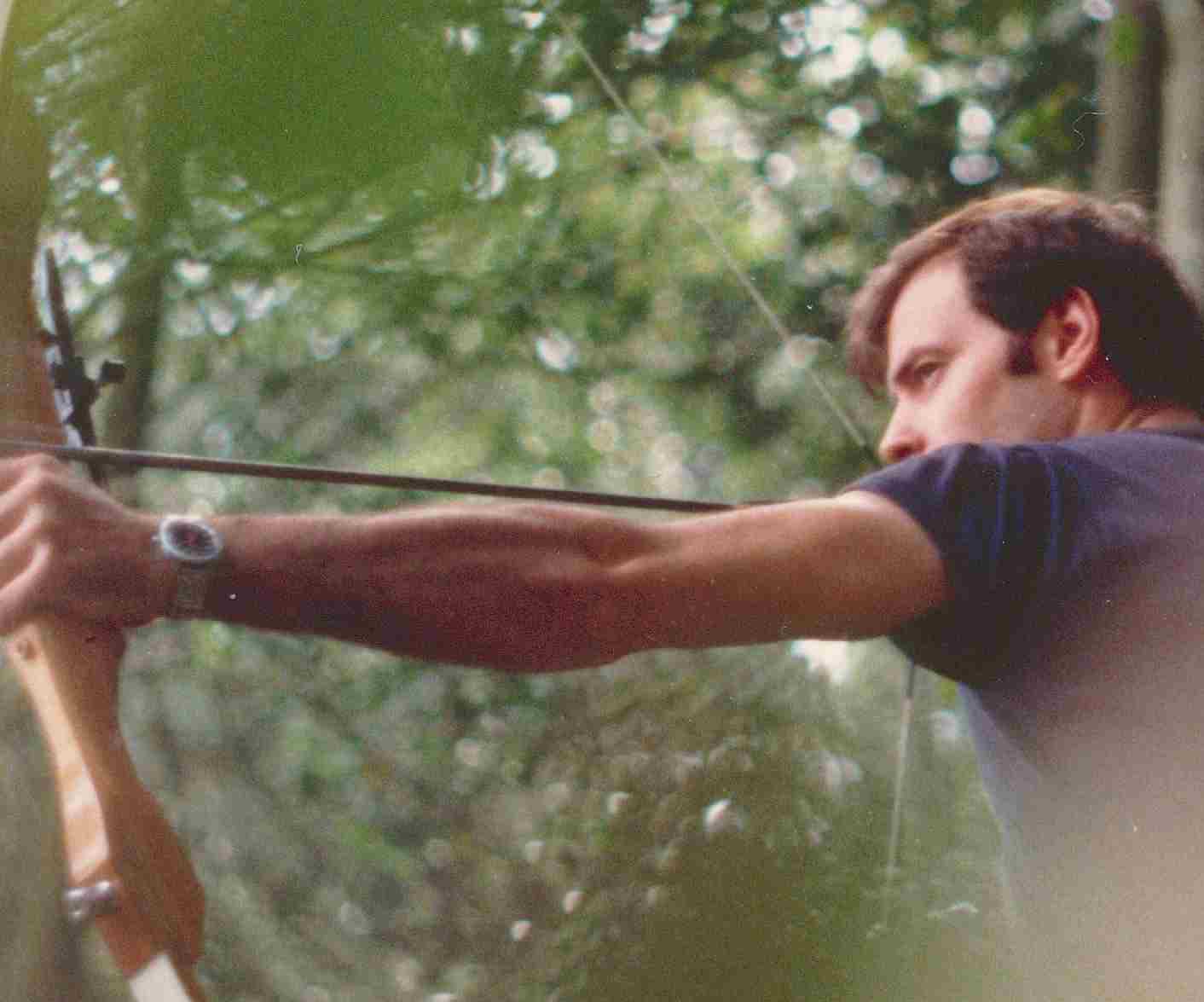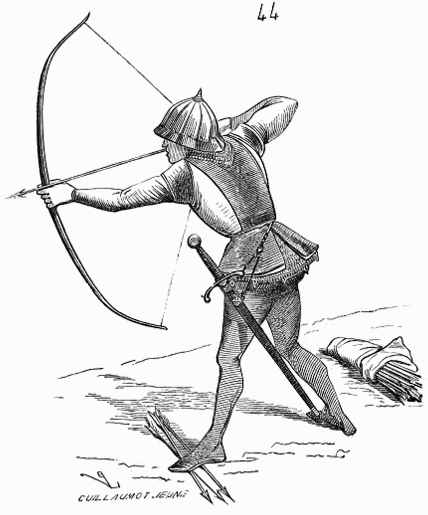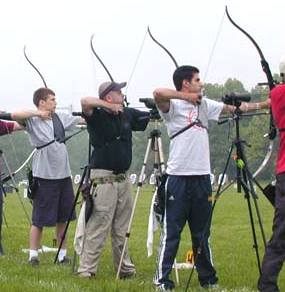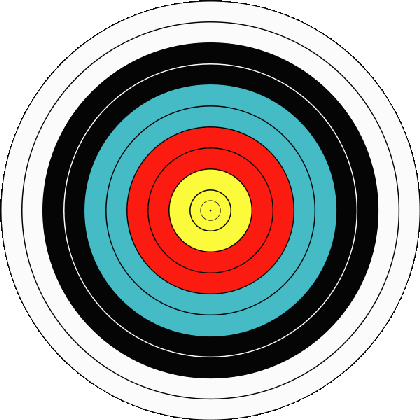|
ARCHERY
|
||||||||
|
Archery is the practice of using a bow to shoot arrows. Archery has historically been used in hunting and combat and has become a precision sport. A person who is fond of or an expert at archery is called a toxophilite.
Nelson hunting scene, by J. A. Walton 1987
History - Beginnings
The earliest concrete evidence of archery dates back 50,000 years. The bow probably originated for use in hunting and was then adopted as a tool of warfare. Bows eventually replaced the atlatl, as the predominant means for launching projectiles. Archery was practiced in antiquity on every inhabited continent except Australia, demonstrating that it is both basic and versatile.
Classical archery
Classical civilizations, notably the Macedonians, Greeks, Persians, Parthians, Indians and Chinese, fielded large numbers of archers in their armies. Arrows proved exceptionally destructive against massed formations and the use of archers often proved decisive. Archers sometimes rode on horseback (horse archers), combining range with speed. Apollo, Odysseus and other mythological characters are often depicted with a bow.
The phrase "A parting shot" comes from the Parthian shot, a technique employed by the Parthians, with the riders turning in the saddle to shoot as they rode away from the enemy.
Medieval European archery
During the Middle Ages, archery in warfare was not as prevalent and dominant, in Western Europe, as popular myth dictates. Archers were quite often the lowest paid soldiers in an army or were conscripted from the peasantry. This was due to the cheap nature of the bow and arrow, as compared to the expense needed to equip a professional man-at-arms with good armour and a sword. The bow was seldom used to decide battles and viewed as a "lower class weapon" or as a toy, by the nobility. This disdain was countered by the Vikings, whose widespread use of archery gave them success in their numerous raiding expeditions all over the Western European seaboard (and even well into the Mediterranean), in the 9th and 10th centuries.
By the time of the Hundred Years' War, the English had learned how to employ massed archery (as opposed to dispersed skirmishing) as an instrument of tactical dominance, with their English longbows. Archers were drawn from the freeholding farmers, known as yeomen and trained rigorously from childhood. Every boy was given a bow of his own height and was required to train with it. Tournaments were sponsored, to encourage proficiency.
In combat, they would often shoot two arrows, one on a high trajectory and one on a low trajectory. These two arrows would hit the enemy simultaneously from two different angles, making defense difficult. The advent of the bodkin point also gave arrows better penetrative power.
Hussite Crossbowman and Shield Carrier during the Hussite Wars
The crossbow, while dating from classical times, became quite popular during the Middle Ages. While it took many years to train a longbowman, someone could become proficient with a crossbow with remarkably little training. The crossbow had about the same power and range as a longbow. Its major drawback however was that it took a long time to reload. The renowned armour-piercing power of the crossbow caused fear amongst the well-armoured nobility and it was banned by the Second Council of the Lateran (at least between Christians), although to little avail.
The advent of firearms rendered bows obsolete in warfare. Although bows had a longer range and could shoot much more frequently than the earliest guns, guns could penetrate most armour and required minimal training. Later development gradually gave firearms advantages over bows in range, accuracy and eventually in reload time. An illustration of the declining popularity of the bow could be seen in the various edicts promulgated by 16th-century English monarchs, to make archery a mandatory practice for all men of fighting age, including Henry VIII's famous ban on the practice of all sports other than archery, on Sundays.
The term "Second String" (or the phrase 'to have more than one string to your bow') derives from the fact that medieval archers would carry a second string, in the event that their "first string" snapped.
Asian archery
Archery was also highly developed in Asia. The horse archers were the main military force of most of the Equestrian nomads. In modern times, horse archery continues to be practised in some Asian countries but is not used in international competition. Central Asian tribesmen were extremely adept at archery on horseback and the Mongols used it to dominate the Eurasian Steppe. Horse archers would shoot while approaching their target, then turn around in the saddle and shoot again after they passed. It is also the official National sport of the Kingdom of Bhutan.
Asian arrows are less stiff than western arrows, with smaller fletchings. Bows vary widely.
The bow is held clasped to the chest, arrow point slightly up. Both arms are extended, the left arm up and toward the target, the right arm back and away from the target. The bow and arrow are drawn down into a line, with both arms locked on opposite sides of the body but the elbow of the right arm is permitted to flex. In some styles the bowstring and fletchings may actually be held behind one's head. The arrow is held at the first joint of the thumb and the string rests on a thumbring (Mongol or Manchu) or a slot at the base of a gauntlet's thumb (Japanese tsuri), so it does not hurt the thumb. A headband may be worn to keep the bowstring from hurting one's ear or head. Thick, loose clothing protects the arms and chest from the bowstring, at release. Warriors on the battlefield often wore leather gauntlets, chest armor and helmets with flared ridges, to protect against the bowstring.
Foot-bows were known and sometimes used in warfare; they were preferred to crossbows because they had a faster firing rate and somewhat longer range. The basic technique was for archers to lie on their backs, with the bows held to their feet; they would put the arrow between their feet, and pull back the string with both hands, using their back and legs to bend the bow. Aiming was poor but with the weight and velocity of the five foot long arrows, combined with massed volleys, this became less important.
Archery was widespread in India. Arjuna's bow, Gandiva, was the Indian equivalent of King Arthur's Excalibur.
Nelson archery practice, photo by J. A. Walton 1987
Recurve target archery
This section focuses on the accepted technique for modern competition (i.e. detailing the typical routine of the shot) which is used worldwide. Many other variations exist, some of which are documented below.
A recurve bow is the only type of bow currently allowed to be shot in the Olympic games.
The bow is held in the hand opposite to the archer's dominant eye. This hand is referred to as the bow hand and its arm the bow arm. The opposite hand is called the drawing hand. Terms such as bow shoulder or string elbow follow the same convention. Right-eye-dominant archers hold the bow with their left hand, have their left side facing the target, sight towards the target with their right eye and handle the arrow and string with their right hand.
Generally one wears a bracer (more commonly known as an arm-guard), to protect the inside of the bow arm and a tab to protect the fingers of the drawing hand. Some archers also wear protection on their chests, called chestguards (see photo). Chestguards are to prevent the bowstring from being obstructed by the archer's physique or clothing as it is released. Of course, it also protects the archer.
To shoot an arrow with a recurve bow, an archer first assumes the correct stance. The body should be perpendicular to the target and the shooting line, with the feet placed shoulder-width apart. As an archer progresses from beginner to a more advanced level an 'open stance' is used/developed. Each archer will have a particular preference but mostly this term indicates that the leg furthest from the shooting line will be a half to a whole foot-length in front of the other, on the ground.
To load, the bow is pointed toward the ground and the shaft of the arrow is placed on an arrow rest which is attached in the bow window. The back of the arrow is attached to the bowstring with the 'nock' (a small plastic component which is typefied by a 'v' groove for this purpose). This is called nocking the arrow. Typical arrows with three vanes should be oriented such that a single vane is pointing away from the bow. This vane is often coloured differently and has numerous names such as index fletch and cock-feather.
The bowstring and arrow are held with three fingers. When using a sight, the index finger is placed above the arrow and the next two fingers below. The string is usually placed in either the first or second joint of the fingers.
The bow is then raised and drawn. This is often one fluid motion which tends to vary from archer to archer. The string hand is drawn towards the face, where it should rest lightly at an anchor point. This point is consistent from shot to shot and is usually at the corner of the mouth or on the chin. The bow arm is held outwards toward the target. The elbow of this arm should be rotated so that the inner elbow is not hyper-extended as this leads to a tendency for the bowstring to scrape the inside of the wrist or to catch on the arm guard when released. The bow should always remain vertical.
In proper form, the archer stands erect, forming a 'T'. The archer's back muscles are used to pull the arrow to the anchor point. Most bows will be equipped with a mechanical device, called a clicker, which produces a clicking sound when the archer reaches the correct draw length.
The arrow is typically released by relaxing the fingers of the drawing hand. An archer should pay attention to the recoil or follow through of his or her body, as it may indicate problems with form (technique).
An English longbowman
Compound Bow Technique
A compound bow is designed to reduce the force that an archer must hold, yet increase the overall energy stored by the bow. Most compound designs use cams or elliptical wheels on the ends of the limbs to optimise the leverage exerted by the archer and to reduce the holding force of the bow, at full draw, while maintaining the force through the draw.
With less force required to hold a compound bow at draw (often less than half of the bow's peak draw weight), the muscles take longer to fatigue, thus giving a compound archer more time to aim. For these reasons, the compound bow is sometimes derogatorily referred to as a "training-wheel bow". In general, good recurve technique usually makes good compound technique. A compound bow must be adjusted, so that its draw length is correct for the archer. The draw length is determined largely by the archer's arm length and shoulder width.
Archers using compounds sometimes use a release aid to hold the string steadily and release it precisely. This attaches to the bowstring at the nocking point and permits the archer to release the string by pulling a trigger.
Padded Arrow Sport
A growing subculture sport activity has recently spawned, over the past 50 or so years, evolving into an organized, if somewhat dubious system of live action combat. A variation of the Roleplay-based LARP, Live Action Wargaming consists of individuals or often groups, numbering from fifty to over three hundred people, dressed in authentic armor and wielding padded sports weapons.
Some systems allow for the use of real bow and arrows in this sport, by limiting the bow draw weight from twenty to forty-five pounds and using blunted, coin-tipped arrows with heads wrapped in open-cell foam padding, thus producing a 'safety arrow'. It should be remembered that these are actual bows and arrows used, so precautions must always be taken and equipment checked frequently.
Unlike other modern-day uses of archery, 'foam archers' must face the difficult use of a far more clumsy projectile with a maximum effective range of perhaps only fifty or sixty feet. Rather than standing still, fantasy sport archers must face the challenge of hundreds of armored players, charging and competing on an actual sport battlefield, while effectively releasing shot upon shot during 'battle', without themselves being attacked or removed from the game, through an 'injury' point system or actual real life injury. Often, such archers are found on the field, releasing arrows as they run.
Hunting
In North America, as with other hunting methods, bowhunting is regulated by individual provinces and states. Regulations often address issues such as where (hunting unit), when (season) and what type (male/female) of individual animal species may be taken. In many cases, a special archery season is set aside, to minimize interference from rifle hunters. In addition, in an effort to maximize game recovery and shot lethality, there are often technical regulations, such as a minimum draw weight for the hunting of big game species.
In contrast to a rifle hunter, who may shoot effectively from ranges in excess of 200 yards (about 180 m), a responsible archer will usually restrict shots to 60 yards (metres) or less, depending on factors such as individual ability, the target animal, draw weight etc. Archers shooting traditional bows (longbows, selfbows or recurves) prefer to shoot at ranges of 20 yards (metres) or less. Although traditional bows are capable of shooting accurately, for much further than 20 yards (metres), ethical hunters restrict their shooting range, in order to ensure quick and humane kills. Because archers must be much closer to their target animal, the bow hunter often claims a more intimate hunting experience and must pay special attention to the animal’s sense of smell, hearing and sight. This limit on effective range is one of the primary challenges that makes the sport of archery hunting attractive.
Game hunted by archers includes all of the North American big game species. People also occasionally fish with modified bows, a practice called bowfishing.
Today, compound bows are usually preferred for hunting, although recurve bows are not uncommon and usually legal. Longbows are often used by those who want to make the hunting experience as traditional as possible but much more skill is needed to achieve a clean hit from a longbow than from other bows. Crossbows are generally permitted for disabled hunters and, in 2005, several states allowed able-bodied hunters to use crossbows, a move that has been somewhat controversial among bow hunters. Some states restrict crossbows to special hunting seasons.
As with any weapon, proper practice and practical training will increase the odds that an animal can be taken successfully and humanely and, in fact, an experienced archery hunter can place a kill shot as effectively as a rifle hunter. However, some European countries consider bowhunting unnecessarily cruel to animals and prohibit the sport. Bowhunting, like target archery, was revived in Britain during the Victorian era but became outlawed when the Wildlife and Countryside Act of 1963 excluded bows and crossbows from its list of permitted hunting weapons. Since 2003, Scotland has been considering the reintroduction of bowhunting, as a means of controlling its deer population. France, Lithuania and Finland have reintroduced bowhunting since 2000. Several other European countries are considering its reintroduction.
Outdoor archery competition
Modern competitive archery
Competitive archery involves shooting arrows at a target for accuracy from a set distance or distances. This is the most popular form of archery worldwide and is called 'Target Archery'. A subset of Target Archery is Field Archery, shot at targets generally set at various distances in a wooded setting. This form of archery is particularly popular in Europe and America. Competitive archery is a sport of precision, and is as much a mental as it is a physical game.
Target Archery
Archery was in the Olympics (and the 1906 interlocated Games) between 1900, the first modern Olympics, and 1920. The sport was dropped from the program because there were no internationally recognized rules for the sport- each Olympics through 1920 held a different type of event. With the creation of FITA in the 1930's, set international rules were created. However, it was not until 1972 that Archery was re-introduced with the individual event, and in 1988 the team event was added to the program. Further competition rules changes were made for the 1992 Olympic Games which introduced match play to the program.
The only type of bow allowed to be used at Olympic level is the recurve bow. Since the 1984 Games at Los Angeles, South Korea has dominated the women's event. At the Sydney 2000 games, the Korean women won bronze, silver and gold in the individual competition and won gold in the team event. They also won the gold team medals in the 2004 Athens games. However, recently, China, Chinese Taipei, and Japan have emerged as serious challengers to the domination of the Korean women.
Modern competitive archery is governed by the International Archery Federation, abbreviated FITA (Fédération Internationale de Tir à l'Arc). Olympic rules are derived from FITA rules. FITA is the IOC (International Olympic Committee) recognized governing body for all of archery. Currently 142 nations are represented by FITA archery governing bodies. The largest of these are the FFTA (French archery federation) with approximately 60,000 members, FITARCO (Italian federation), DSB (German federation), AJAF (All-Japan archery federation), and the GNAS (Grand National archery Society) of Great Britain. In the United States the FITA affiliated governing body is USA Archery (National Archery Association of the United States) which dates to the 1870's.
Rules
Archery competitions may be held indoors or outdoors. Indoor distances are 18 m and 25 m. Outdoor distances range from 30 m to 90 m (for senior archers, juniors can shoot closer distances), with 70 m being used in the Olympic Games. Most outdoor competitions consist of several distances.
Competition is divided into ends. An archer shoots either 3 or 6 arrows per end, depending on the type of round. After each end, the competitors walk to the target to score and retrieve their arrows. There are 20 ends of 3 arrows in a round of indoor competition.
Archers have a set time limit in which to shoot their arrows. For indoor competition, under FITA rules this is 2 minutes for 3 arrows. Signaling devices such as lights and flags inform the archers when time is up. Since archery involves the use of potentially lethal equipment, much attention is paid to order and safety. All competitors must wait for the command to start shooting and are not allowed to collect arrows while other people are shooting.
Scoring
Targets are marked with 10 evenly spaced concentric rings, which have score values from 1 through 10 assigned to them. In addition, there is an inner 10 ring, sometimes called the X ring. This becomes the 10 ring at indoor compound competitions. Outdoors, it serves as a tiebreaker with the archer scoring the most X's winning. In FITA archery, targets are coloured as follows:
Archers score each end by summing the scores for their arrows. Line breakers, an arrow just touching a scoring boundary line, will be awarded the higher score. Values scored by each arrow are recorded on a score sheet and must be written in descending order (e.g. if an archer scores 5, 7, 6, 10, 9, 8, this must be recorded as 10, 9, 8, 7, 6, 5.) During and before scoring no one is allowed to touch the arrows. This is so that if there is disputed arrow score then a judge may be called and the judge will make a ruling on how the arrow lies. After scoring, each hole is marked before arrows are retrieved. In the event of a "pass through" (the arrow passes straight through the target) or "bouncer" (arrow hits the target and bounces out), points may be awarded to an unmarked hole.
Different rounds and distances use different size target faces. Common sizes (and example rounds they are used in) are:
122 cm faces are used in Olympic competition. There are also versions of the 40cm and 60cm targets known as the "3 Spot". The targets contain 3 instances of the inner 5 rings of the 40cm and 60cm faces arranged in a line or an equilateral triangle. This is to stop competitors from damaging their own arrows by shooting a "robin hood".
Field Archery
Field archery involves shooting at targets of varying marked (and sometimes unmarked) distance, often in rough terrain.
Three common types of rounds (in the NFAA) are the field, hunter, and animal. A round consists of 28 targets in two units of 14. Field rounds are at 'even' distances up to 80 yards (some of the shortest are measured in feet instead), using targets with a black bullseye (5 points), a white center (4) ring, and black outer (3) ring. Hunter rounds use 'uneven' distances up to 70 yards, and although scoring is identical to a field round, the target has an all-black face with a white bullseye. Children and youth positions for these two rounds are closer, no more than 30 and 50 yards, respectively. Animal rounds use life-size 2D animal targets with 'uneven' distances reminiscent of the hunter round. The rules and scoring are also significantly different. The archer begins at the first station of the target and fires his first arrow. If it hits, he does not have to fire again. If it misses, he advances to station two and fires a second arrow, then to station three for a third if needed. Scoring areas are vital (20, 16, or 12) and nonvital (18, 14, or 10) with points awarded depending on which arrow scored first. Again, children and youth shoot from reduced range.
One goal of field archery is to improve the technique and abilities required for bowhunting in a more realistic outdoor setting, but without introducing the complication and guesswork of unknown distances. As with golf, fatigue can be an issue as the athlete walks the distance between targets across sometimes rough terrain.
3D Archery
3D archery is a subset of field archery focusing on shooting at life-size models of game, and is popular with hunters. It is most common to see unmarked distances in 3D archery, as the goal is to accurately recreate a hunting environment for competition.
On these animals there are 4 rings, only 3 of these are used in ASA shoots. The one that isn't used very often is the 14 ring. This can only be scored if you call it before you shoot, and if it is even allowed. Next is the 12 ring inside of the 10 ring, inside of the 8 ring. Anything on the target that is outside of the 8, 10, 12, or 14 rings is a 5. If you miss the target, you score a zero.
Other competition
Clout Archery (G.N.A.S. rules in the United Kingdom)
Similar to target archery, except that the archer attempts to drop arrows at long range (180 yards / 165 m for the men and 140 yards / 128 m for women; there are shorter distances for juniors depending on age) into a group of concentric circular scoring zones on the ground surrounding a marker flag. The flag is 12 inches (30 cm) square and is fixed to a stick. The flag should be as near to the ground as is practicable. Archers shoot 'ends' of six arrows then, when given the signal to do so, archers proceed to the target area. A Clout round usually consists of 36 arrows. Clout tournaments are usually a 'Double Clout' round (36 arrows shot twice). They can be shot in one direction (one way) or both directions (two way). All bow types may compete (longbows, recurve, barebow and compound).
Roving Marks
The oldest form of competitive archery, as practiced by Henry VIII. The archers will shoot to a "mark" then shoot from that mark to another mark. A mark is a post or flag to be aimed at. As with clout a rope or ribbon is used to score the arrows. In the Finsbury Mark the scoring system is 20 for hitting the mark, 12 for within ~3ft, 7 points for within the next ~6ft and 3 points for within the next ~9ft.
Darts
Like a big darts game, at a greater distance and using a proportional sectorized target.
Flight Archery
Flight Archery can only take place where space permits since archers compete by shooting for sheer distance. Archers shoot a number of arrows and then search for the one which has been shot the farthest, marking it with an identifiable marker. At the end of the round, archers stand or sit by their furthest arrows while judges measure the distances they were shot. There are many classes that one can shoot in, depending on the type of bow and its draw force.
Golf Archery
This variation of Clout Archery uses the same rules and field as the classic golf, excpt the ball replaced by an arrow and the clubs replaced by a bow. There is sometimes competition between a golfer and an archer. The field shall of course be free of other golfers.
Beursault
A traditional northern French and Belgian archery contest. Archers teams shoot alternatively at two targets facing each other, 50 meters away. A perpendicular array of wooden walls secures a path parallel to the shooting range. After each round, the archers take their own arrow and shoot directly in the opposite direction (thus having opposite windage). One shoots always the same arrow, supposedly the best built, as it was difficult in medieval times to have constant arrow quality. The round black-and-white target mimics the size of a soldier: its diameter is shoulder-wide, the center is heart-sized and centered at 1.30m from the ground.
Popinjay (or Papingo)
A form of archery originally derived from shooting birds on church steeples. Popinjay is popular in Belgium, but little known elsewhere. Archers stand within 12 feet (3.7 m) of the bottom of a 90 ft (27 m) mast and shoot almost vertically upwards with 'blunts' (arrows with rubber caps on the front instead of a pile), the object being to dislodge any one of a number of wooden 'birds'. These birds must be one Cock, four Hens, and a minimum of twenty-four Chicks. A Cock scores 5 points when hit and knocked off its perch; a Hen, 3; and a Chick, 1 point.
Ski archery
An event very similar to biathlon except a recurve bow is used in place of a gun. The athletes ski around a cross-country track and there are two stances in which the athlete must shoot the targets: kneeling and standing. During competition the skis must not be removed at any time. The athlete may unfasten the ski when shooting in the kneeling position but must keep the foot in contact with the ski. The shooting distance is 18 meters and the targets 16cm in diameter. In certain events, for every missed target, the athlete must ski one penalty loop. The loop is 150 meters long.
Archery education
A relatively new program has developed in schools called the National Archery in Schools Program (NASP). In this students use Genesis bows (a compound-style bow without draw stops). This is like a P.E. unit and students who want to can also go to state and national shoots with their schools to compete against other schools. Though started in the United States, it has started to spread to other nations.
An official FITA target
Related
Civilizations notable for archery
LINKS
A - Z SPORTS INDEX
A taste for adventure capitalists
Solar Cola - a healthier alternative
|
||||||||
|
This website is Copyright © 1999 & 2020. The bird logo and name Solar Navigator are trademarks. All rights reserved. All other trademarks are hereby acknowledged. Max Energy Limited is an educational charity. |

